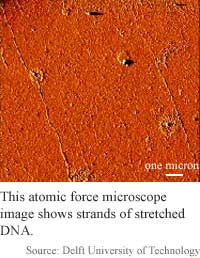
Plastic
pins DNA molecules in place
By
Eric Smalley,
Technology Research NewsDNA molecules are extremely long and are usually coiled up. Getting them to lie flat and straight and stay in place has challenged many a lab technician, whether in studying their role as the blueprints for life or using them as building blocks of nanotechnology.
A research team based at Delft University of Technology has developed a technique to position, stretch out and pin down DNA molecules with nanometer-scale precision.
The technique combines the previously developed process of DNA combing, which stretches out DNA molecules, with photolithography, and also takes advantage of the affinity DNA molecule ends have for polystyrene.
"Single molecules of DNA can be stretched, patterned and directed site-specifically onto an arbitrary surface [when] molecular combing... is used in combination with current lithographic techniques," said Dionne C. G. Klein, a graduate student at Leiden University.
The researchers demonstrated the technique by using electron beam lithography to produce a grid of polystyrene lines two microns wide and 17.5 microns apart on a gold-covered silicon wafer. Polystyrene is used to make hard plastics and Styrofoam.
They submerged the wafer in water containing molecules of the DNA from a bacteria-infecting virus. Because the ends of the DNA molecules are hydrophobic, they bind to the polystyrene, which is also hydrophobic.
The researchers then comb the DNA by slowly drawing the wafer out of the water. The surface tension exerts a strong enough force to pull the loose ends of the DNA molecules straight but not strong enough to pull the fixed ends loose from the polystyrene. "The single-stranded DNA ends bind to the [polystyrene] and the meniscus of the solution forces the coiled DNA to stretch," said Klein.
The free end of each molecule, which can stretch to more than 20 microns long, then attaches to the next polystyrene line in the grid.
The method keeps the DNA molecules lined up. The researchers found that the DNA molecules did not attach both ends to the same polystyrene line.
The researchers also fixed stretched DNA molecules to unpatterned polystyrene surfaces.
Positioning, stretching and pinning DNA molecules makes it easier for researchers to examine them with atomic force and scanning tunneling microscopes. It is also a step toward eventually using DNA molecules to make integrated circuits much smaller than today's computer chips.
"Patterned DNA on a substrate can serve as a template for wires and for two-and three-dimensional nanoscale devices," said Klein.
Klein's research colleagues were Leonid Gurevich, Jorg W. Janssen and Leo P. Kouwenhoven of Delft University of Technology and Jeffrey D. Carbeck and Lydia L. Sohn of Princeton University. They published the research in the April 16, 2001 issue of the journal Applied Physics Letters.
The research was funded by the Foundation for Fundamental Research on Matter in the Netherlands, the Exploratory Research for Advanced Technology program in Japan and the National Science Foundation.
Timeline: Now
Funding: Government
TRN Categories: Biological, Chemical, DNA and Molecular Computing
Story Type: News
Related Elements: Technical paper, "Ordered stretching of single molecules of deoxyribose nucleic acid between microfabricated polystyrene lines," Applied Physics Letters, April 16, 2001
Advertisements:
May 2/9, 2001
Page One
Jolts yield nanotube transistors
Simulation hints at quantum computer power
Metal makes DNA more conductive
Etching process points to nanotech production
Plastic pins DNA molecules in place

News:
Research News Roundup
Research Watch blog
Features:
View from the High Ground Q&A
How It Works
RSS Feeds:
News
Ad links:
Buy an ad link
| Advertisements:
|
 |
Ad links: Clear History
Buy an ad link
|
TRN
Newswire and Headline Feeds for Web sites
|
© Copyright Technology Research News, LLC 2000-2006. All rights reserved.